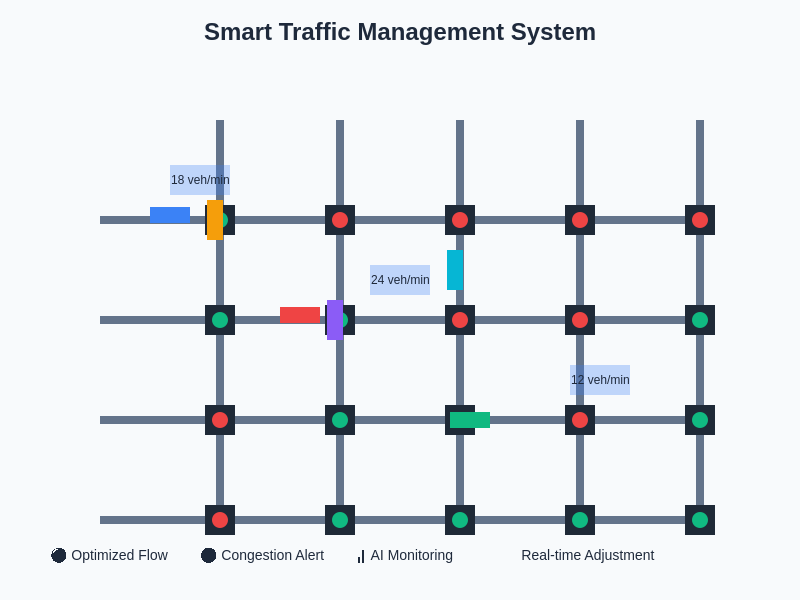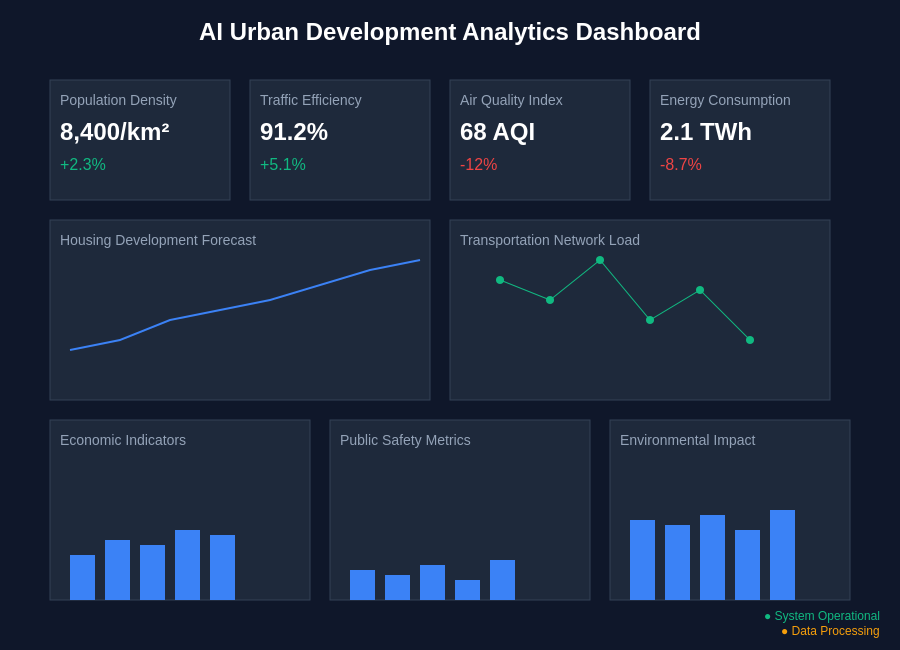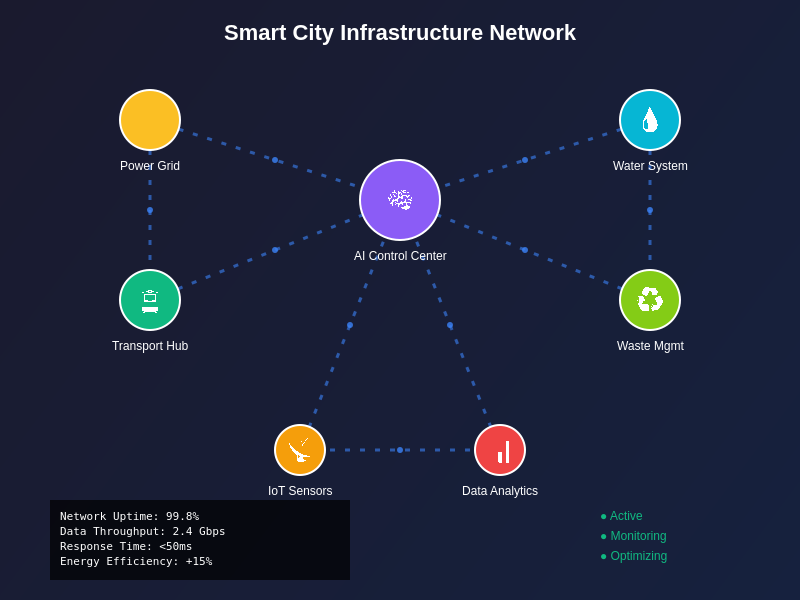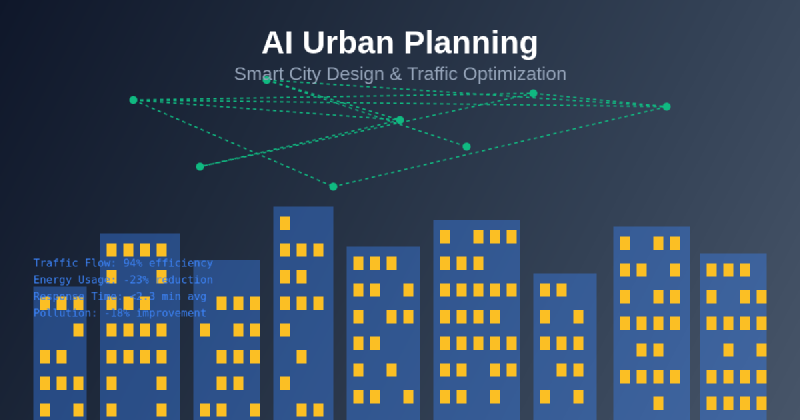The rapid urbanization of our world presents unprecedented challenges that demand innovative solutions, and artificial intelligence has emerged as the transformative force capable of addressing these complex urban dynamics. As cities grow larger and more complex, traditional planning methods struggle to cope with the intricate web of infrastructure, transportation, housing, and environmental concerns that define modern metropolitan areas. AI-powered urban planning represents a paradigm shift from reactive city management to proactive, data-driven approaches that optimize resource allocation, enhance quality of life, and create sustainable urban environments for future generations.
Explore the latest AI innovations in urban technology to understand how cutting-edge developments are shaping the cities of tomorrow. The integration of artificial intelligence into urban planning processes has created opportunities for unprecedented precision in city design, enabling planners to simulate complex scenarios, predict urban growth patterns, and optimize infrastructure investments with remarkable accuracy and foresight.
The Foundation of AI-Driven Urban Planning
The evolution of urban planning from traditional methodologies to AI-enhanced approaches represents one of the most significant transformations in city development practices. Traditional urban planning relied heavily on historical data, manual surveys, and intuitive decision-making processes that often failed to account for the dynamic nature of urban systems. AI-driven planning introduces sophisticated computational models that can process vast amounts of real-time data, analyze complex urban interactions, and generate optimized solutions that account for multiple variables simultaneously.
This technological revolution has enabled urban planners to move beyond static master plans toward dynamic, adaptive planning frameworks that can respond to changing demographics, economic conditions, and environmental factors. Machine learning algorithms can identify patterns in urban development, predict future growth trends, and suggest optimal land use configurations that maximize efficiency while minimizing negative environmental and social impacts. The result is a more scientific, evidence-based approach to urban development that produces measurable improvements in city functionality and resident satisfaction.
Intelligent Traffic Management and Flow Optimization
Traffic congestion represents one of the most visible and costly challenges facing modern cities, with economic losses from traffic delays measured in billions of dollars annually across major metropolitan areas. AI-powered traffic management systems have revolutionized how cities approach transportation optimization by implementing intelligent algorithms that can analyze traffic patterns in real-time, predict congestion bottlenecks, and automatically adjust traffic signal timing to maintain optimal flow conditions.
These sophisticated systems utilize machine learning models trained on historical traffic data, weather conditions, special events, and other variables that influence transportation patterns. The AI can identify subtle correlations between different factors and traffic flow that human operators might miss, enabling more precise and effective traffic management strategies. Smart traffic signals equipped with AI algorithms can reduce average commute times by up to thirty percent while simultaneously reducing fuel consumption and vehicle emissions through more efficient routing and flow management.

The implementation of AI-driven traffic optimization extends beyond simple signal timing adjustments to encompass comprehensive transportation network management. Advanced systems can coordinate traffic signals across entire city districts, manage highway on-ramp metering, and even integrate with ride-sharing services to optimize vehicle deployment and reduce overall traffic volume. This holistic approach to transportation management represents a fundamental shift toward treating city transportation networks as integrated, intelligent systems rather than collections of independent components.
Experience advanced AI planning capabilities with Claude for comprehensive urban development analysis and optimization strategies. The sophistication of modern AI systems enables city planners to model complex scenarios and evaluate the potential impacts of various development strategies before implementation, significantly reducing the risk of costly planning mistakes and ensuring more successful urban development outcomes.
Data-Driven Infrastructure Planning and Resource Allocation
Modern cities generate enormous amounts of data through sensors, mobile devices, social media, and administrative systems, creating unprecedented opportunities for evidence-based infrastructure planning and resource allocation. AI systems can analyze these diverse data streams to identify infrastructure needs, predict maintenance requirements, and optimize resource distribution across different city services and geographical areas. This data-driven approach enables cities to make more informed decisions about capital investments and infrastructure development priorities.
The predictive capabilities of AI systems have proven particularly valuable for infrastructure maintenance and replacement planning. Machine learning algorithms can analyze patterns in infrastructure performance, environmental conditions, and usage data to predict when roads, bridges, water systems, and other critical infrastructure components are likely to require maintenance or replacement. This predictive approach enables cities to schedule maintenance activities more efficiently, reduce emergency repairs, and extend the useful life of infrastructure investments through optimal maintenance timing.
Resource allocation optimization represents another area where AI has demonstrated significant value in urban planning applications. Cities must balance limited budgets across competing priorities such as transportation, housing, education, public safety, and environmental protection. AI algorithms can analyze demographic data, service utilization patterns, and outcome metrics to recommend optimal resource allocation strategies that maximize public benefit while staying within budgetary constraints. This optimization capability helps ensure that public resources are deployed where they can have the greatest positive impact on community welfare.
Environmental Monitoring and Sustainable Development
Environmental sustainability has become a critical priority for urban development, and AI technologies provide powerful tools for monitoring environmental conditions, predicting environmental impacts, and optimizing city operations for reduced environmental footprint. Smart sensor networks equipped with AI analytics can monitor air quality, noise levels, energy consumption, and water usage in real-time, providing city managers with detailed insights into environmental performance and identifying opportunities for improvement.
AI-powered environmental monitoring systems can detect pollution sources, track environmental trends over time, and predict the environmental impacts of proposed development projects. This capability enables cities to make more informed decisions about development approvals, environmental mitigation measures, and regulatory enforcement priorities. Machine learning algorithms can identify subtle patterns in environmental data that might indicate emerging problems, enabling proactive responses that prevent more serious environmental issues from developing.
The optimization of city operations for environmental sustainability represents another important application of AI in urban planning. Smart building management systems can optimize energy consumption based on occupancy patterns, weather conditions, and energy pricing. Intelligent waste management systems can optimize collection routes and schedules based on actual waste generation patterns, reducing fuel consumption and improving service efficiency. These AI-driven optimizations contribute to measurable reductions in city environmental impacts while often producing cost savings that help justify the technology investments.
Housing Development and Demographic Analysis
Housing affordability and availability represent critical challenges for cities worldwide, and AI technologies provide valuable tools for analyzing housing markets, predicting housing needs, and optimizing housing development strategies. Machine learning algorithms can analyze demographic trends, economic indicators, and housing market data to predict future housing demand patterns and identify optimal locations for different types of housing development.
AI-powered demographic analysis can reveal subtle patterns in population growth, migration, and housing preferences that inform more effective housing policies and development strategies. These systems can identify neighborhoods experiencing rapid demographic change, predict gentrification pressures, and suggest interventions to maintain housing affordability and community stability. The ability to model different policy scenarios enables city planners to evaluate the potential impacts of various housing policies before implementation, reducing the risk of unintended consequences.
The optimization of housing development projects represents another valuable application of AI in urban planning. Machine learning algorithms can analyze site conditions, transportation access, environmental factors, and regulatory requirements to recommend optimal housing designs and development strategies. This optimization capability can help developers create more successful projects while ensuring that new housing developments contribute positively to neighborhood character and community goals.
Enhance your research capabilities with Perplexity for comprehensive analysis of urban development trends and best practices from cities worldwide. Access to global knowledge and research capabilities enables urban planners to learn from successful AI implementation strategies in other cities and adapt these approaches to local conditions and requirements.
Public Safety and Emergency Response Optimization
Public safety represents a fundamental responsibility of city government, and AI technologies have created new opportunities for optimizing police deployment, emergency response, and crime prevention strategies. Predictive policing algorithms can analyze crime patterns, demographic data, and environmental factors to identify areas with elevated crime risk, enabling more effective deployment of police resources and proactive crime prevention efforts.
Emergency response optimization represents another critical application of AI in urban planning and management. Machine learning algorithms can analyze emergency response data to identify optimal ambulance and fire station locations, predict emergency call volumes, and optimize emergency response routes. These optimizations can significantly reduce emergency response times, potentially saving lives and reducing property damage from emergencies. AI systems can also coordinate emergency responses across multiple agencies, ensuring more effective and efficient emergency management.
The integration of AI-powered public safety systems with other city systems creates opportunities for comprehensive public safety optimization. Smart city sensors can automatically detect emergencies such as fires, accidents, or security threats and immediately alert appropriate response agencies. Traffic management systems can automatically adjust signal timing to expedite emergency vehicle movement. These integrated approaches to public safety represent the future of urban emergency management and demonstrate the power of AI to improve city services through system integration and optimization.
Economic Development and Business Intelligence
Cities compete for businesses, investment, and economic development opportunities, and AI technologies provide powerful tools for analyzing economic trends, identifying development opportunities, and optimizing economic development strategies. Machine learning algorithms can analyze business formation patterns, employment trends, and economic indicators to identify emerging industry clusters and predict future economic development opportunities.
AI-powered business intelligence systems can help cities understand their competitive position relative to other cities and identify strategies for improving their attractiveness to businesses and investors. These systems can analyze factors such as workforce availability, infrastructure quality, regulatory environment, and quality of life indicators to recommend improvements that could enhance economic competitiveness. The ability to model different economic development scenarios enables cities to evaluate the potential impacts of various policies and investments before implementation.
The optimization of economic development incentives represents another valuable application of AI in urban economic planning. Machine learning algorithms can analyze the effectiveness of different incentive programs and recommend optimal incentive structures that maximize economic development benefits while minimizing public costs. This evidence-based approach to economic development helps ensure that public resources invested in economic development activities generate maximum return on investment for the community.

The comprehensive analysis capabilities of AI systems enable cities to monitor economic performance in real-time and quickly identify emerging trends or challenges that require attention. This real-time economic intelligence supports more agile and responsive economic development strategies that can adapt quickly to changing economic conditions and opportunities.
Transportation Network Integration and Mobility Solutions
Modern cities require integrated transportation networks that seamlessly connect different modes of transportation and provide efficient mobility options for residents and visitors. AI technologies enable sophisticated analysis and optimization of transportation networks that can improve connectivity, reduce travel times, and enhance the overall transportation experience. Machine learning algorithms can analyze travel patterns across different transportation modes to identify optimal integration points and suggest improvements to network connectivity.
The emergence of shared mobility services such as ride-sharing, bike-sharing, and scooter-sharing has created new opportunities and challenges for urban transportation planning. AI systems can analyze usage patterns for these services and optimize their integration with traditional public transit systems. This optimization can include coordinating schedules, optimizing service locations, and managing capacity to ensure that shared mobility services complement rather than compete with public transportation options.
Autonomous vehicle integration represents the next frontier in AI-powered transportation planning. As autonomous vehicles become more prevalent, cities will need sophisticated AI systems to manage mixed traffic environments that include both autonomous and human-driven vehicles. These systems will need to optimize traffic flow, manage parking resources, and coordinate with autonomous vehicle systems to ensure safe and efficient transportation networks. The planning and infrastructure requirements for autonomous vehicle integration represent a significant opportunity for AI-powered urban planning to shape the future of city transportation.
Citizen Engagement and Participatory Planning
Effective urban planning requires meaningful citizen engagement and participation in planning processes, and AI technologies have created new opportunities for enhancing public participation and incorporating citizen input into planning decisions. AI-powered analysis of social media, surveys, and public comments can identify citizen concerns and preferences more effectively than traditional public engagement methods. Natural language processing algorithms can analyze large volumes of citizen feedback to identify common themes and priority issues.
Interactive planning platforms powered by AI can enable citizens to explore different development scenarios and provide feedback on proposed projects. These platforms can visualize the potential impacts of development projects and help citizens understand how proposed changes might affect their communities. The ability to engage citizens in more meaningful and informed discussions about urban development can lead to better planning outcomes and stronger community support for development projects.
AI systems can also help cities identify and address equity concerns in planning processes by analyzing demographic data and citizen feedback to ensure that planning decisions consider the needs of all community members. Machine learning algorithms can identify patterns that might indicate inequitable distribution of city services or development benefits, enabling cities to address these disparities through more targeted and effective planning strategies.
Smart Grid and Energy Infrastructure Planning
Energy infrastructure represents a critical component of urban planning, and AI technologies provide powerful tools for optimizing energy generation, distribution, and consumption across city systems. Smart grid technologies powered by AI can analyze energy demand patterns, predict peak usage periods, and optimize energy distribution to minimize waste and reduce costs. These systems can integrate renewable energy sources more effectively and help cities achieve sustainability goals while maintaining reliable energy services.
The planning of energy infrastructure for future city growth requires sophisticated modeling and analysis capabilities that AI systems can provide. Machine learning algorithms can predict energy demand growth based on demographic trends, economic development patterns, and climate factors. This predictive capability enables cities to plan energy infrastructure investments more effectively and avoid capacity shortages or overinvestment in energy systems.
Building energy optimization represents another important application of AI in urban energy planning. Smart building management systems can learn from occupancy patterns, weather conditions, and energy pricing to optimize heating, cooling, and lighting systems automatically. The aggregation of building-level optimizations across entire city districts can produce significant energy savings and reduce strain on city energy infrastructure.

The integration of energy systems with other city infrastructure creates opportunities for comprehensive optimization that AI systems are uniquely capable of managing. For example, electric vehicle charging infrastructure can be coordinated with energy grid management to optimize charging schedules and reduce peak demand pressures. These integrated approaches to infrastructure planning represent the future of smart city development and demonstrate the transformative potential of AI in urban planning.
Future Directions and Emerging Technologies
The future of AI-powered urban planning will likely include even more sophisticated technologies and applications that are currently in development or early deployment stages. Digital twin technology, which creates detailed virtual models of city systems, combined with AI analytics, will enable unprecedented precision in urban planning and management. These digital twins can simulate the impacts of proposed changes before implementation, reducing the risk of planning mistakes and enabling more confident decision-making.
The integration of Internet of Things sensors throughout city infrastructure will provide AI systems with even more detailed and real-time data about city operations and citizen behavior. This enhanced data collection capability will enable more precise optimization and prediction capabilities, leading to better planning outcomes and more responsive city services. The challenge for cities will be managing and analyzing these vast amounts of data effectively while protecting citizen privacy and ensuring data security.
Blockchain technology integration with AI planning systems may provide new opportunities for transparent and accountable planning processes. Smart contracts could automate certain planning approvals and ensure that development projects meet specified criteria before proceeding. The combination of blockchain transparency with AI optimization could create new models for democratic and efficient urban planning that better serve citizen interests while maintaining planning effectiveness.
The continued advancement of AI technologies promises to unlock even greater potential for urban planning optimization and innovation. As these technologies mature and become more accessible, even smaller cities will be able to implement sophisticated AI-powered planning systems that were previously available only to major metropolitan areas. This democratization of advanced planning capabilities has the potential to improve urban development outcomes across cities of all sizes and enhance quality of life for urban residents worldwide.
Disclaimer
This article is for informational purposes only and does not constitute professional urban planning or policy advice. The views expressed are based on current understanding of AI technologies and their applications in urban planning. Readers should consult with qualified urban planning professionals and consider local regulations and requirements when implementing AI-powered planning technologies. The effectiveness of AI systems may vary depending on specific urban contexts, data availability, and implementation approaches.
